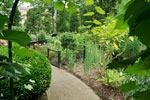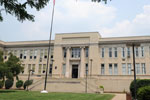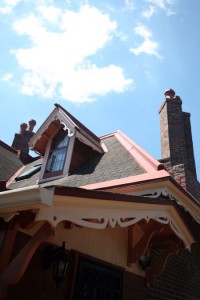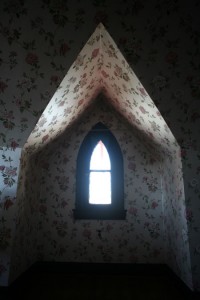
Category Archive: PHLF Historic Landmarks
-
Historical Groups Left in Lurch by Funding Cuts
By Richard Robbins, Pittsburgh TRIBUNE-REVIEW
Sunday, July 25, 2010
Museum inn keeper and Curator Jim Koontz, of Ligonier, builds a birdhouse that is being modeled after the Laughlintown museum's cook house. Barry Reeger/Tribune-Review
Just two years ago, Soldiers & Sailors Memorial Hall & Museum, the Oakland landmark honoring veterans of all of America’s wars, was on the receiving end of a nice piece of change from Pennsylvania: $260,000.
In 2009, the state’s largesse shrank dramatically, to a mere $30,000.
This year, Soldiers & Sailors is in line to get nothing, a result of a state budget that eliminated grants for historical sites, from the 218-acre Bushy Run Battlefield in Penn Township to the smallest local historical society.
The funding cuts will have a huge impact on groups devoted to local history, according to Ronald Gancas, Soldiers & Sailors president and CEO.
He foresees severe retrenchments, including the continuation of a wage freeze in effect at Soldiers & Sailors since 2007 and the need to recruit and mobilize even more volunteers. The museum’s education department has gone from five full-time and two part-time employees a few years ago to one full-time and one part-time employee today.
“If this trend continues, it will take 50 years to put things back together,” Gancas said.
The 2009 state budget contained $1.7 million for regional and local history, a sum that the state House added after several months in which it appeared there would be no funding for historical groups.
But this time around, there was no late change to rescue local history grants, either for general operations or special projects.
There was lip-service support for public history from members of the General Assembly but nothing more, said Deborah Filipi, executive director of the Pennsylvania Federation of Museums and Historical Organizations.
“We are in a crisis, there is no doubt about it,” Filipi said. “There are some museums that are already hurting. I suspect some of these are not going to survive.”
Jeremy Burnworth, president of the Fayette County Historical Society, said the funding cuts could not come at a worse time for his group, which conducted a ribbon-cutting ceremony Friday at its new museum and headquarters in a renovated 1700s building.
“This is really bad timing,” Burnworth said, adding that the historical society will be “held back without” the state dollars. He was counting on $10,000 from the state and a $10,000 match from the county to help staff the museum and the Searight Tollhouse, both along the National Road.
“We were on track” for the funding, Burnworth said. Now the game plan is to utilize volunteers in place of paid staff.
Tina Yandrick, director of operations for the Ligonier Valley Historical Society, said the expiration of funding meant elimination of summer internships cutting general maintenance “over and above the usual.”
Yandrick noted Compass Inn, a restored Laughlintown stagecoach stop built in 1799, “always” needs refurbishing.
Nevertheless, she said, “we are fortunate we have Compass Inn,” a money-maker for the society that helps to offset the loss of state money.
State funding was “always important money for us,” said Lisa C. Hays, executive director of the Westmoreland County Historical Society, adding that money has been so scarce, “I’m trying to get through this month.”
“We’ve already tightened our belts a lot,” Hays said. She forecast the potential for shorter business hours beginning in 2011 to “save staff time.” However, because the society likely will make a greater effort to raise private dollars, Hays was uncertain if savings are actually possible.
-
Rodef Shalom’s Garden Grows into Latest Exhibit of Wearable Greens
By Alaina Raftis , TRIBUNE-REVIEW
Thursday, July 15, 2010
The heavily cultivated and well-maintained garden -- which sits on a third of an acre off of Fifth Avenue in Oakland -- was created by Irene Jacob, a botanist who founded the docent program at Phipps Conservatory and Botanical Gardens, and her husband, Rabbi Walter Jacob, to bring people closer to the Bible in a nontraditional way. Justin Merriman | Tribune-Review
The lush greenery at Rodef Shalom’s Biblical Botanical Garden is celebrating it’s 25th year with a new exhibit titled “What Shall I Wear?”
This year, the garden showcases various plants and flowers that have been used to make clothing and fragrances for thousands of years.
The heavily cultivated and well-maintained garden — which sits on a third of an acre off of Fifth Avenue in Oakland — was created by Irene Jacob, a botanist who founded the docent program at Phipps Conservatory and Botanical Gardens, and her husband, Rabbi Walter Jacob, to bring people closer to the Bible in a nontraditional way.
Often referred to as “Little Israel” because its geography replicates the confines of the Holy Land, the garden features various miniature landmarks such as Mt. Hermon, a mound of stones stacked beneath the shade of the billowing Acacia trees, and the Jordan River, a tranquil stream of water trickling from one corner of the garden to another.
The thousands of signatures penned in the guest book each season are only one sign of the garden’s success.

Often referred to as "Little Israel" because its geography replicates the confines of the Holy Land, the garden features various miniature landmarks such as Mt. Hermon, a mound of stones stacked beneath the shade of the billowing Acacia trees, and the Jordan River, a tranquil stream of water trickling from one corner of the garden to another. Justin Merriman | Tribune-Review
“This is the largest and most complete garden of its kind,” says Arlyn Gilboa, who has been a docent at the garden for 15 years, “It’s wholly dedicated.”
The garden contains 56 out of 110 plants specifically mentioned in the Bible and an additional 50 flowers that Jacob added to awaken the verdant oasis.
“Some people come to Pittsburgh just to see the garden,” says Jean Simon, another docent.
Plants that aren’t mentioned in the Bible were given creative names such as, “Jacob’s Coat,” “Angel’s Tears” and “Elijah’s Blue” to play along with the biblical theme.
This year’s exhibit “was just something new that we haven’t focused on before,” Gilboa says. “Sometimes our exhibits don’t have biblical roots, but this year it certainly does.”

The garden contains 56 out of 110 plants specifically mentioned in the Bible plus more. Justin Merriman | Tribune-Review
Some of the plants featured in this year’s exhibit are used for the essential oils in perfumes and fragrances. They include, among others, banana shrubs, carnations, chamomile, gardenia, geranium, jasmine, kumquat, lemon verbena, mock orange, musk plant, myrtle, patchouli, rose, rosemary and sage. The cotton and flax plants also are displayed and both have been used to make clothing since the ancient times.
“It’s a wonderful thing,” Gilboa looks at the two massive Cedar of Lebanon trees at the entrance to the garden. “The fact is that the ancients were dependent on plants, and so are we. For me, I feel a strong connection with Jewish history when I’m here. It’s such a treat.”
Rodef Shalom Biblical Botanical GardenWhen: Through Sept. 15. Hours: 10 a.m.-2 p.m. Sundays-Thursdays; 7-9 p.m. Wednesdays; noon-1 p.m. Saturdays Guided tours available 12:15-1 p.m. Aug. 6 and Sept. 3
Admission: Free
Where: Rodef Shalom Temple, 4905 Fifth Ave., Oakland
Details: 412-621-6566
-
Kids Can Get Hands on With Historical Games at Old Economy Village
By Kellie B. Gormly, PITTSBURGH TRIBUNE-REVIEW
Thursday, July 15, 2010Long before the days of battery-operated Buzz Lightyear toys and Wiis, kids had to get pretty creative in order to make toys and play games.
Children in the 19th century would amuse themselves with activities like rolling hoops with sticks, and doing “Lady Ann’s ring tosses,” which involved a stick tied to a wooden circle about the size of a doughnut. Kids would toss the stick around, and try to catch the circle with it. In another old-fashioned game, quoits, people would throw rings to land around a peg in the ground. Many of the toys were made with scrap wood that came from building houses.
“They had to make their own toys, mostly,” says Lynn Popovich, who is organizing a play-themed event at Old Economy Village this weekend. “You couldn’t go to the store and buy them. … Most of the toys back then were creative things that the parents sort of invented when the kids were little to keep them busy.”
On Saturday, Old Economy Village — which re-opened in April, after a state budget crisis closed the National Historic Landmark for a few months — will let its visitors explore, learn about and try out toys and games from the 1800s, when the Harmonists from Germany settled the Beaver County village. Hands On History Day features the old-fashioned amusements, along with arts and crafts, sack races, a historical scavenger hunt, and more. Kids can get their pictures taken while wearing reproduction 19th-century clothing, attend an 1830s schoolhouse session, watch puppet shows, play old instruments like kazoos, and more.
The activities will allow visitors of all ages to step back in time and enjoy getting a feel for early American life, says Popovich, who is the village’s volunteer coordinator and store manager.
“We just want them to come and have a fun time and experience the days of yore … with their children,” she says. “It’s something for the entire family. There aren’t a lot of activities where kids and parents can enjoy themselves together. They can walk around the garden, pavilion and gazebo, sit on the bench and reflect how people lived back then.
Kids, Popovich says, are “fascinated, I think, with how the children of yesterday lived, without the modern conveniences.”
“They love playing with the old-fashioned toys,” she says. “You wouldn’t think that they’d be interested because they’re so involved with iPods .. and all that high-tech stuff.”
Hands On History Day includes demonstrations from a blacksmith, weaver, broommaker, baker and other artisans, and visitors can try out these activities, Popovich says. The Ambridge Steel Drum Band will be performing at 1 and 3 p.m. Hot dogs, drinks and other snacks will be sold.
During school tours at the village, she says, the kids are fascinated by how their predecessors amused themselves without batteries and electricity.
_______________________________________________________________________________________
Hands On History Day_______________________________________________________________________________________When: 10 a.m.-5 p.m. Saturday
Admission: $9 for age 11-64; $6 for ages 3-11; $8 for age 65 and older; free for age 2 and younger
Where: Old Economy Village, 270 16th St., Ambridge, Beaver County
Details: 724-266-4500 or website
-
Former Turtle Creek High School’s Architecture, Importance Honored
By Tom Fontaine
PITTSBURGH TRIBUNE-REVIEW
Thursday, July 15, 2010
On Saturday, officials will unveil two historical markers that commemorate the former Turtle Creek High School building's architectural significance and role in the community. Officials debated about demolishing the building five years ago, but a group led by former graduates Jill Hinkle, Bob Mock, Jeanne Flaherty and Connie Morenzi led vocal opposition. The Classical Revival-style, cream-colored brick building with stone and terra cotta trim was designed by Pittsburgh architect George Henry Schwan. Jasmine Goldband | Tribune-Review
The former Turtle Creek High School building has gone by several names and narrowly avoided the wrecking ball to remain a community centerpiece since opening during World War I.
On Saturday, officials will unveil two historical markers that commemorate the Monroeville Avenue building’s architectural significance and role in the community.
Although the markers were installed last week, the building was placed on the National Register of Historic Places three years ago and received historic designation last fall from the Pittsburgh History and Landmarks Foundation.
“It basically validates what people in Turtle Creek have felt all along,” said councilwoman Jill Henkel of the markers. Henkel is a 1978 graduate of the former Turtle Creek High School and one of four Turtle Creek natives who led a push to obtain historical designation for the building.
Ground was broken on the $200,000 building in August 1917, and it opened in February 1919 as Union High School, with students from Turtle Creek, Wilmerding, East Pittsburgh and parts of nine other communities, according to documents related to the National Register of Historic Places designation.
The Classical Revival-style, cream-colored brick building with stone and terra cotta trim was designed by Pittsburgh architect George Henry Schwan. He also designed the Twentieth Century Club’s original building in Oakland, the former Oakmont High School and laid out plans for factory-worker developments in Aliquippa and Akron, Ohio.
The building wasn’t home to just high school classes.
Westinghouse employees trained at night in classrooms and vocational shops. Women used school sewing machines after hours to earn money during the Great Depression. And the school’s large lawn provided “the only open green space in the borough,” Henkel said.
“Even today, people are always playing in it,” Henkel said of the lawn. “It’s basically a community park.”
The school would hit a peak enrollment of more than 2,100 students in the 1930s. Also in that decade, after East Pittsburgh and Wilmerding opened their own high schools, Union’s name was changed to Turtle Creek High School. In 1940, the school graduated just 365 students.
When Turtle Creek became part of the newly created Woodland Hills School District in the 1980s, the building became the new district’s East Junior High. Officials debated about demolishing the building five years ago, but a group led by former graduates Hinkle, Bob Mock, Jeanne Flaherty and Connie Morenzi led vocal opposition.
Ultimately, the district moved East Junior High students elsewhere and mothballed the Turtle Creek building for the 2008-09 school year; it reopened last August, housing the district’s new Woodland Hills Academy for elementary students.
“I would have laid down in front of the bulldozer if they tried to tear down the building,” said Mock, a 1968 graduate.
The unveiling of the marker, part of Turtle Creek Community Days festivities, begins at 7:30 p.m. on Saturday at 126 Monroeville Ave.
-
Pittsburgh’s Union Trust building finally gets major tenant
by Ben Semmes
Pittsburgh Business Times
August 4, 2008The Union Trust Building in Downtown Pittsburgh has secured a major office tenant at last.
Siemens Power Generation Inc. will consolidate about 500 local employees on three floors at the nearly 600,000-square-foot, 11-story structure — formerly known as Two Mellon Center. It has been mostly vacant since Mellon Financial Corp. pulled its employees out of the property in May 2006.
The 185,000-square-foot lease, which puts a significant dent in one of Pittsburgh’s largest office vacancies, will run for 10 years at the 501 Grant St. building, according to the Pittsburgh office of CB Richard Ellis Inc., which represented both the building’s owner and Siemens in the deal.
Orlando, Fla.-based Siemens Power Generation’s local operations, known collectively as Siemens Environmental Systems and Services, have employees at three Pittsburgh sites: 441 Smithfield St., Downtown; One Oxford Centre, at 301 Grant St., also Downtown; and 40 24th St., in the Strip District.
Earlier this year the state pledged $2.95 million in grants and tax credits to Downtown Pittsburgh-based Wheelabrator Air Pollution Control Inc., the division of Siemens Power Generation based at 441 Smithfield St., to assist with a $5 million expansion. The company agreed to hire at least 550 employees over three years as part of the expansion.
The company will begin moving into the Union Trust Building later this year with full occupancy set for the fourth quarter of 2008.
A Siemens spokesperson was not immediately available for comment Monday.
Simultaneously, the building’s new owners — California investors led by Los Angeles-based Mika Realty — are conducting an extensive renovation of the property with plans for LEED certification, a new lobby and installation of a lower level parking facility.
Serving as an operations center for Mellon Bank since the mid-1980s, the Union Trust Building was originally constructed between 1915 and 1917 by steel magnate Henry Clay Frick as a shopping arcade.
bsemmes@bizjournals.com | (412) 208-3829
-
Heathside Cottage’s mystery adds to its appeal
By Bob Karlovits
TRIBUNE-REVIEW
Saturday, July 19, 2008 It sits atop Fineview, peering over Downtown like one of the gargoyles that lurk through the house.
It sits atop Fineview, peering over Downtown like one of the gargoyles that lurk through the house.
Jack Miller from the Pittsburgh History & Landmarks Foundation knows some of the history of the home — known as Heathside Cottage — that could have been on its perch before the Civil War. It is dated 1855 on a plaque near its bay window, but continuing research debates that."The story is in the bricks," Miller says with a sigh.
 Charm from the 19th century is an obvious feature of the home the foundation has up for sale. The two-bedroom home with solidly repointed brick, plastered walls and decorative wood inside and out is being marketed at $189,900.
Charm from the 19th century is an obvious feature of the home the foundation has up for sale. The two-bedroom home with solidly repointed brick, plastered walls and decorative wood inside and out is being marketed at $189,900.The home, which had a guest spot in Rick Sebak’s 1977 "North Side Story," also has a one-car garage, a stylistically matching shed, a bricked patio and a garden area that once was a dilapidated home next door.
"I love it," says filmmaker Sebak about the home. "It is the kind of house that just makes you want to visit and spend some time there."The home is small with high ceilings in its two main levels, but low ones in the basement where former owner Judith Harvey hung signs saying: "The ceiling is low, the archways lower, anyone over 5 feet, DUCK."
Upstairs, the 10- and 11-foot ceilings give space to rooms that otherwise are tight and small. It is not a home for big parties, big people or big families.
The first floor consists of a kitchen-dining room, parlor and den. Upstairs are two bedrooms and a bath, with a skylight over the staircase adding another touch of airiness to the home.
The outside is dominated by ornate, wooden trim that Miller jokes earned the home the name of the "witch’s house" from neighborhood kids.
Harvey, who is retired, serves as librarian of the Frank B. Fairbanks Rail-Related Archive for the foundation. She moved out of the home at the end of June.
 Harvey bought the home in 1992 as a project to restore. After her husband died in 1996, she moved in permanently and continued her work, adding ornamental gargoyles as she went. In 2000, she entered into an arrangement with the foundation known as a retained life estate.
Harvey bought the home in 1992 as a project to restore. After her husband died in 1996, she moved in permanently and continued her work, adding ornamental gargoyles as she went. In 2000, she entered into an arrangement with the foundation known as a retained life estate.Under that arrangement, Miller says, the title of the home was transferred to the foundation, but she retained the right to live there. She remained responsible for taxes and maintenance, but received a charitable income-tax deduction.
She also received a similar deduction this year for the unused part of her donation to the foundation. History & Landmarks officials then received control of the property to manage or market whatever way they wished,
Harvey does not want to discuss matters, but Miller says he believes she simply grew tired the work that comes along with taking care of a property.
Al Tannler, director of historical collections for the History & Landmarks, says no data exists on the construction of the home. But it may be related to a cluster of like homes called Evergreen Hamlet in Ross.
Col. James Andrews, a self-taught stone mason and engineer, bought the Fineview property in 1862, so Tannler believes he "had the home built and may have named it" Heathside, which shows up on a stone above the bay window.
He did work for Joseph Kerr (1816-1888), an architect who designed the Gothic Revival Evergreen Hamlet homes. Therefore, Tannler suggests, Kerr is a likely suspect for the design of Heathside.
That whole story, though, puts it behind the 1855 date, but that doesn’t matter too much, he says.
 "It’s significance is its rare quality," he says, "and the fact that it is one of a few of its kind."
"It’s significance is its rare quality," he says, "and the fact that it is one of a few of its kind."Bob Karlovits can be reached at bkarlovits@tribweb.com or 412-320-7852.
-
Cathedral of Learning trumpets education
By Bill Zlatos
TRIBUNE-REVIEW
Sunday, June 29, 2008The Cathedral of Learning was constructed of Indiana limestone and built with the pennies, nickel and dimes of area schoolchildren.John G. Bowman, then chancellor of the University of Pittsburgh, came up with the idea for a tower in 1921.
“He wanted a tall building because his intention was the children of working men and women of Pittsburgh would see the tower and be inspired to get an education,” said Albert Tannler, historical collections director at the Pittsburgh History & Landmarks Foundation.

But there was the issue of money. The cost of the building was estimated at $10 million to $15 million, a hefty sum in those days.
In 1925, Marcus Aaron, chairman of the city’s board of education, summoned the district’s teachers to start a “Buy a Brick” campaign. The teachers told students to give 10 cents to Pitt and tell the university how they earned it. The children would get a certificate indicating they owned a piece of the building.As a result, 97,000 certificates were issued.Parents also gave. In 1926, Bowman went to a meeting of steelworkers and their families in Carnegie to promote his tower.
“A woman stood up with a baby in her arms and said, ‘We got no money, but we’ll go without meat for a week and give you that money.’ Then a man stood up and said, ‘I’ll wear this suit another year and give you the money,’ ” said Maxine Bruhns, director of Pitt’s Nationality Rooms and Intercultural Exchange Programs, who is working on a DVD, “The Story Behind the Construction of the Cathedral of Learning.”
The cathedral is home to 27 Nationality Rooms, which showcase the culture of the ethnic groups that built Pittsburgh.
The steel skeleton of the building was erected in 1929. After the stock market crashed, the 52-story design was shortened to 40. Still, it was the tallest academic building in the world when it was finished in 1937. It remains the biggest in the United States.
“It was a triumph,” Bruhns said, “symbolizing that those parallel lines going skyward never meet and education never ends.”
Bill Zlatos can be reached at bzlatos@tribweb.com or 412-320-7828.
-
$80 million Schenley tab challenged
By Christian Morrow
June 27, 2008
The New Pittsburgh Courier

